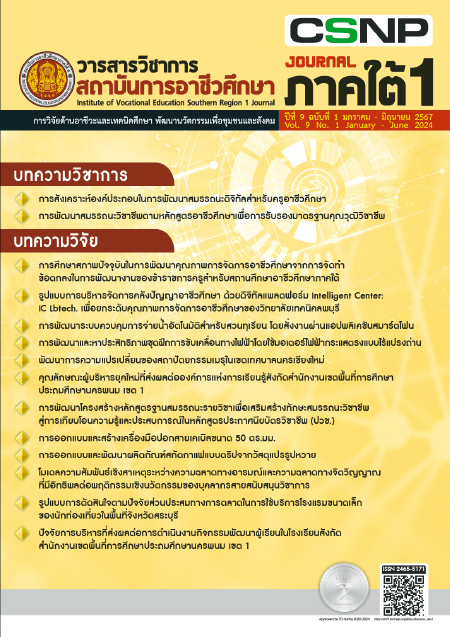Design and Development of Drip Coffee Extraction Products from Processing Rattan
Keywords:
Drip Coffee, Processing Rattan, Innovation in Handicraft Product DesignAbstract
The objective of the research was to develop drip coffee extraction products using processing rattan. This research and development study employed rattan which is local economic plants of southern Thailand by gathering in-depth information through the interview of coffee consumers, rattan weaving experts, and design experts to establish guidelines for the synthesis of a development process for the prototype product.
The study revealed that using Choong Nang weaving pattern was the most suitable for producing a drip coffee extraction device. This weaving pattern allows coffee dripping smoothly. Therefore, two prototypes were developed, i.e., a solid weaving pattern and an open weaving pattern. It was found that the solid weaving pattern was deemed the most appropriateness as a showcase representing Thai culture through basketry work and giving a natural distinctive aroma while dripping coffee. The product, then, was sold online to get feedbacks from consumers and experts. The suggestions were on finer weaving of the inside surface to increase the product’s values. Based on the feedbacks received, adjustments were made to the weaving design to express the value of weaving through contemporary products with natural materials. This would help generate interest among the new generations and support those involved in rattan basketry to continue their craftsmanship for sustainable Thai handicraft.
References
ศูนย์อัจฉริยะเพื่ออุตสาหกรรมอาหาร. (2564). [ออนไลน์]. ตลาดกาแฟในประเทศไทยปี 2564. [สืบค้นเมื่อวันที่ 20 กันยายน 2565]. จาก https://fic.nfi.or.th/market-intelligence-detail.php?smid=364.
Positioning. (2564). [ออนไลน์]. ตลาดกาแฟปี 2563. [สืบค้นเมื่อวันที่ 20 กันยายน 2565]. จาก https://positioningmag.com/1337014.
กรมป่าไม้. (2561). [ออนไลน์]. แผนแม่บทบริหารจัดการทรัพยากรไผ่และหวายแห่งชาติ พ.ศ. 2561-2579. [สืบค้นเมื่อวันที่ 26 กันยายน 2565]. จาก https://www.tei.or.th/file/events/2018-inbar-plan_24.pdf.
Kurasu. (2021). [ออนไลน์]. เลือกดริปเปอร์ยังไงให้เหมาะกับตัวเอง. [สืบค้นเมื่อวันที่ 25 กันยายน 2565]. จาก https://kurasubkk.com/th/blogs/new-blog/how-to-choose-the-dripper-which-one-is-right-for-you.
มยุรี เรืองสมบัติ ยุวดี พรธาราพงศ์ นพพร สกุลยืนยงสุข และดรุณรัตน์ พิกุลทอง. (2555). การออกแบบและพัฒนาผลิตภัณฑ์หัตถกรรมกรณีศึกษาเฟอร์นิเจอร์จากหวายเทียม. กรุงเทพมหานคร: คณะสถาปัตยกรรมศาสตร์และการออกแบบ มหาวิทยาลัยเทคโนโลยีราชมงคลพระนคร.
พรพิมล ศักดา และบวร เครือรัตน์. (2561). การพัฒนาผลิตภัณฑ์ชุมชนประเภทของใช้จากวัสดุธรรมชาติของกลุ่มอาชีพเสริมบ้านสุขเกษม ตำบลบางเลน อำเภอบางเลน จังหวัดนครปฐม. นครปฐม: มหาวิทยาลัยเทคโนโลยีราชมงคลรัตนโกสินทร์.
นลินทิพย์ เศวตสุวรรณ. (2557). โครงการออกแบบชุดกาแฟดริปที่ได้รับแรงบันดาลใจมาจากลวดลายโอ่งราชบุรี. ปริญญาศิลปะบัณฑิต ภาควิชาเครื่องเคลือบดินเผา คณะมัณฑนศิลป์ มหาวิทยาลัยศิลปากร, นครปฐม.
ประทักษ์ คูณทอง. (2565). [ออนไลน์]. การศึกษาลวดลายหัตถกรรมเครื่องจักรสานพื้นบ้านท้องถิ่น เพื่อเป็นแนวทางในการออกแบบและพัฒนาลวดลายบนเครื่องเรือน: กรณีศึกษา กลุ่มหัตถกรรมเครื่องจักสานบ้านหนองขอน อำเภอเมือง จังหวัดอุบลราชธานี. [สืบค้นเมื่อวันที่ 26 กันยายน 2565]. จากhttps://homepoom2017.files.wordpress.com/2016/09/02_e0b89be0b8a3e0b8b0e0b897e0b8b1e0b881e0b8a9e0b98c-e0b884e0b8b8e0b893e0b897e0b8ade0b887.pdf.
Downloads
Published
Issue
Section
License
Copyright (c) 2024 Institute of Vocational Education Southern Region 1 Journal

This work is licensed under a Creative Commons Attribution-NonCommercial-NoDerivatives 4.0 International License.



